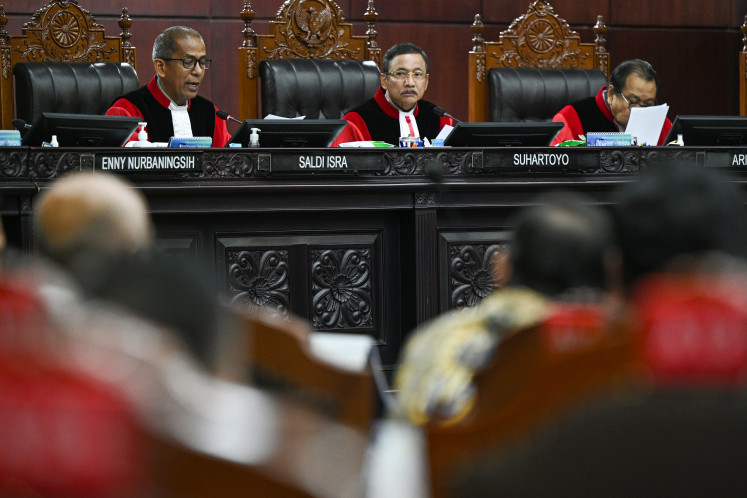Popular Reads
Top Results
Can't find what you're looking for?
View all search resultsPopular Reads
Top Results
Can't find what you're looking for?
View all search resultsChina, Islam and reviving the Silk Road
Han style: Tongxin Great Mosque in Wuzhong City evinces a typically Han architecture, save for its crescent moon on the roof
Change text size
Gift Premium Articles
to Anyone
H
span class="caption">Han style: Tongxin Great Mosque in Wuzhong City evinces a typically Han architecture, save for its crescent moon on the roof. JP/Ina Parlina
The Tongxin Great Mosque in Wuzhong City ' about two hours' drive south of Yin-chuan, the capital of Ningxia province ' is a pearl of well-preserved Islamic culture in China.
Built in the 14th century, the mosque is one of the oldest Muslim places of worship in the Communist state. Its structure is reminiscent of typical Han Chinese buildings, except for the Islamic decorations ' including the crescent moon that sits on its top.
A screen stands in front of the main entrance, while the calligraphy of a Koran verse decorates the center of a brick wall. It reads: 'And the places of worship are for God alone: so invoke not anyone along with God.'
Thick green curtains serve as the door to the main worship hall, which according to mosque director Wang Fengyuan can seat up to 1,000 people.
The wooden floor, funded by a Malaysian businessman in 2005, is entirely covered by carpets. Prayer beads are easily found under the ends of the rugs.
The mosque also provides headscarves for women entering the hall, where Muslims gather to study Islam and recite the Koran. Prominent Muslim scholars used to lecture here.
Wang says minority Hui Muslims can freely perform religious activities while enjoying privileges from Beijing, thanks in part to their support of the Communists in the 1930s.
Wang was referring to American journalist Edgar Snow's influential book Red Star over China, which records some of the interactions between Communist leaders and the minority Hui Muslims during the Long March.
The Tongxin Great Mosque also played a part in the foundation of the People's Republic of China: in October 1936, it hosted a public meeting that led to the formation of the Yuwang Hui Autonomous Government, the first autonomous, albeit short-lived, county in Communist China.
In fact, the mosque was protected as a revolutionary historic site and was the only major Islamic building in Ningxia to survive destruction during the Cultural Revolution.
Najiahu Mosque in Yongning county, north of Yinchuan is another witness of the long history of Islam in China. It was named after Nasruddin, a descendent of Ali and Fatima, the daughter of the Prophet Muhammad.
One of Nasruddin's sons was said to have settled at the current site of the mosque in the 16th century. Almost all the residents of the village are Muslims; most carry the family name Na.
One of the boards with Arabic inscriptions tells the origin of the Na family and the mosque. 'My family left Qing [Central China] and moved to Western Xia and built this mosque during Emperor Jiajing's reign,' it reads.
Pious: A member of China's Muslim Hui minority group reads the Koran in a mosque in Wuzhong city in Ningxia Hu. JP/Dwi Atmanta
Ding Yao Xian, the mosque's administrative committee director, says the local government has allocated RMB 10 million for the mosque's upkeep this year, including renovation to host fast-breaking meals during Ramadhan.
The mosque is situated near the newly-built China Hui Culture Park, where Hui culture and traditions are displayed and the history of Islam in China can be traced.
Islam is said to have spread to China along the Silk Road, which includes the current Ningxia province, during the Tang Dynasty in the 8th century.
Watching the life of the Hui community in Ningxia province today, however, the rich heritage of Islam in China does not seem to correlate with China's current economic might.
The Hui people economically lag behind the majority ethnic group.
That was why in September 2012, China's State Council approved the Ningxia Inland Opening-up Pilot Economic Zone and Yinchuan Comprehensive Bonded Zone.
The former is billed as 'China's strategic highland opening to the west, China's important energy and chemical industry base and China's major industrial cluster of halal food and Muslim commodity'.
The launch of the zones provides a new platform for China, Arab states and other Muslim regions to strengthen economic, trade and cultural exchange and cooperation, which in the end will hopefully improve the welfare of the local people.











